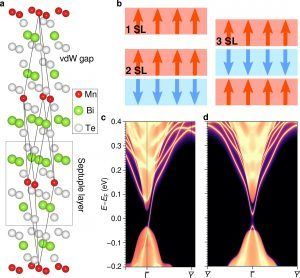Unique Thickness-Dependent Properties of the van der Waals Interlayer Antiferromagnet MnBi2Te4 Films
Layered van der Waals compounds containing 3d transition metal elements have recently attracted a great deal of attention for two main reasons: (i) their ultrathin films represent remarkable examples of two-dimensional magnets with very stable magnetic properties, and (ii) such compounds have proven promising in the field of topologically-nontrivial materials. Using state-of-the-art ab initio techniques and the Monte Carlo method, we have studied the layered van der Waals antiferromagnet MnBi2Te4 in the two-dimensional limit and found it to show remarkable magnetic and topological properties.
MnBi2Te4 is a material that has a block-layered crystal structure, in which thin laminae made of seven atomic layers, called septuple layer blocks, show strong covalent-ionic bonding inside them and relatively weak van der Waals bonding to the neighboring laminae. In principle, such a crystal structure of MnBi2Te4 facilitates the preparation of thin films with a septuple layer block precision. Concerning its magnetic order, it appears to be an interlayer antiferromagnet, where the ferromagnetic Mn layers of neighboring blocks are coupled antiparallel to each other.

Figure. (a) Atomic structure of MnBi2Te4 with red, green, and white balls showing Mn, Bi, and Te atoms, respectively. (b) 1-, 2-, and 3-septuple-layer(SL)-thick MnBi2Te4 films, showing a ferromagnetic, compensated antiferromagnetic, and uncompensated antiferromagnetic orders, respectively. (c,d) Edge electronic band structures of the MnBi2Te4 2-SL-thick film calculated for the ferromagnetic (c) and compensated antiferromagnetic (d) states. The presence of the edge mode in the fundamental band gap of the film (c) indicates the QAH phase, while the gapped edge spectrum (d) is a proof of the zero plateau QAH state.
Based on density functional theory and Monte Carlo calculations, we predict the MnBi2Te4 thin films to show a unique set of magnetic and topological transitions as a function of number of septuple layer blocks in the film: while a single septuple layer block of MnBi2Te4 is a topologically trivial ferromagnet, the thicker films made of an odd (even) number of blocks are uncompensated (compensated) interlayer antiferromagnets, which show quantum anomalous Hall (zero plateau quantum anomalous Hall) states. Additionally, the predicted wide band gaps and relatively high magnetic critical points for the MnBi2Te4 films are expected to facilitate the observation of the quantum anomalous Hall (QAH) effect at temperatures significantly higher than those achieved so far, something that would be a significant advance.
From practical point of view, this achievement is also very important since the QAH effect represents a promising playground for the creation of novel devices, e. g., chiral interconnects, expected to outperform ordinary copper interconnects currently used in commercially available chips. Furthermore, MnBi2Te4 is the first stoichiometric material predicted to realize the zero plateau QAH state, which has been theoretically shown to host the exotic axion insulator phase. In contrast to the previously studied sandwich-like FM1/TI/FM2 heterostructures (where FM1 and FM2 are two different ferromagnetic insulators and TI is a nonmagnetic topological insulator), the MnBi2Te4 thin films realize the zero plateau QAH state intrinsically, i.e. without the need of applying an external magnetic field.



